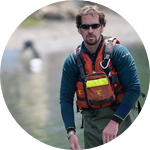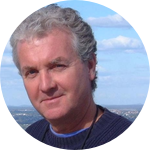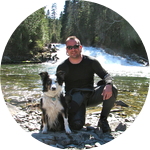About This Project
The numbers of Atlantic salmon within many Atlantic Canada rivers are at historically low levels. Salmon deliver marine-derived nutrients (MDNs), which are key for maintaining enhanced levels of stream productivity. By releasing wild origin adult salmon, our program uses MDNs as a whole river restoration tool to subsidize the river and help increase productivity and ecosystem functioning, as well as a conservation tool to save an endangered species.
Ask the Scientists
Join The DiscussionWhat is the context of this research?
Returning adults not only provide offspring for future generations, they subsidize rivers with MDNs to sustain productivity. The lack of MDN inputs from almost nonexistent returns, acts as a limiting factor to salmon production and survival. This project directly addresses how the currently low productive state of these rivers as a result of extremely low returns is limiting food resources necessary to sustain elevated populations of juvenile salmon. Introduced adults bring with them crucial MDNs that in turn creates a positive feedback mechanism that influences ecosystem integrity and productivity. Carrying capacity for Atlantic salmon depends on properly functioning biogeochemical cycles and diverse food webs, both of which are strongly dependent on Atlantic salmon.
What is the significance of this project?
Resource availability plays a primary role in stream dynamics, and the availability of resources can influence community structure and ecosystem functioning. This study illustrates the significance that increasing primary production may extend to recovering a species. A more advanced understanding of the role that Atlantic salmon play in freshwater ecosystems is crucial for a comprehensive approach to mitigate the limiting factors associated with salmon production and survival in freshwaters.
What are the goals of the project?
This project will use direct measures of biofilm community metabolism and biofilm biomass to quantify changes in primary productivity as a result of supplementing rivers with adult salmon to increase ecosystem functioning. The funds will be used to analyze samples to quantify primary producer biomass.
Biofilm will be collected from rocks during pre spawning (summer 2017) and spawning periods (fall 2017) in areas with and without (above a natural barrier) salmon. This upstream-downstream, temporal approach has been used to evaluate the effects of MDNs in several studies. Abundance is determined by quantifying concentrations of biofilm algal pigments.
Budget
In order to effectively assess whether releasing wild origin adult Atlantic salmon increases primary productivity and therefore ecosystem functioning, we need to measure the biomass of primary producers. Chlorophyll analysis allows us to measure the amount of photosynthetic pigments present which serves as a measure of overall abundance. increased primary producer abundance is needed to maintain elevated ecosystem function and productivity. By collaborating with groups working on these rivers and a relatively small contribution we can demonstrate that not only are salmon important for freshwater productivity, but that we can use productivity (increases through MDN addition) as a river restoration tool.
Endorsed by
Meet the Team
Affiliates
Kurt Samways
I am currently a PhD student at the University of new Brunswick.
My current research is focused on identifying the relative roles of marine-derived nutrients (MDNs) in regulating freshwater productivity and in turn, influencing the condition and survival of resident and non-resident fishes. With returns of anadromous fish declining dramatically in the past century throughout Atlantic Canada, the delivery of MDNs to rivers has been reduced. The role of MDNs transport in coastal rivers is a function of net nutrients transferred by all anadromous fish and collectively may result in MDN subsidies equivalent to those delivered by salmon on the Pacific coast. The current scarcity of these fishes in Atlantic Canada may have profound effects on aquatic production, particularly in nutrient-poor systems. My approach to address this combines observational studies, experimental frameworks, and analytical techniques (including stable isotope and fatty acid analysis) to understand the linkages between freshwater and marine ecosystems.
Lab Notes
Nothing posted yet.
Project Backers
- 3Backers
- 1%Funded
- $10Total Donations
- $3.33Average Donation


